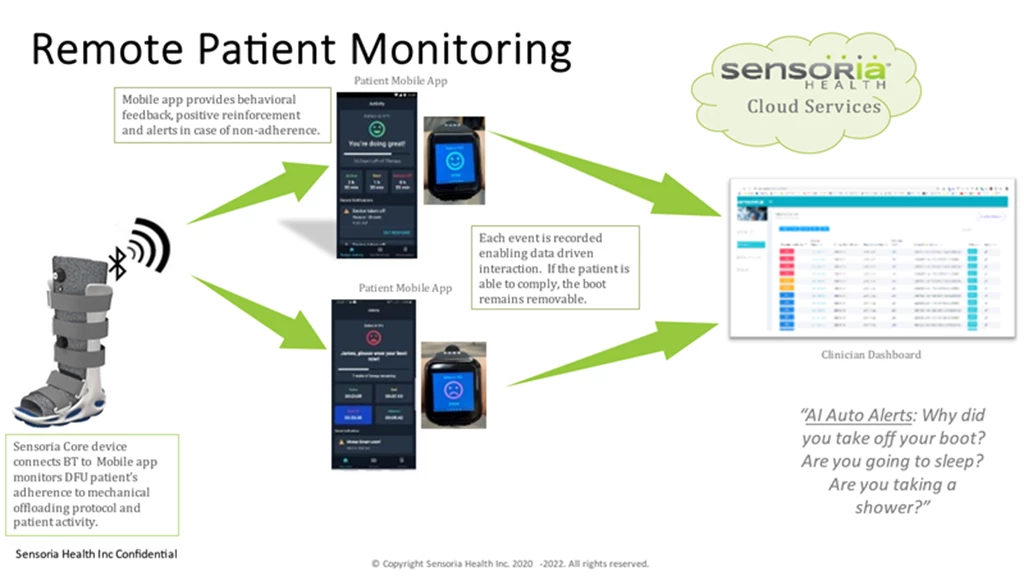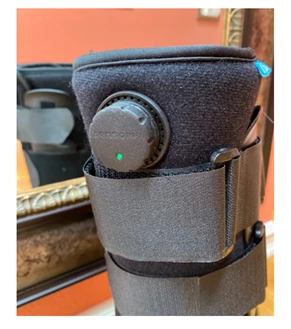Azure Health Data Services, Integration, Partners
Accelerating innovation in the diabetic foot market with Azure Health Data Services
Posted on
5 min read
This blog post has been co-authored by Sharlene Jerome, Manager of Marketing and Communications, Sensoria Health
This blog is part of a series in collaboration with our partners and customers leveraging the newly announced Azure Health Data Services. Azure Health Data Services, a platform as a service (PaaS) offering designed exclusively to support Protected Health Information (PHI) in the cloud, is a new way of working with unified data—providing care teams with a platform to support both transactional and analytical workloads from the same data store and enabling cloud computing to transform how we develop and deliver AI across the healthcare ecosystem.
According to the World Health Organization, over 422 million people suffer from diabetes. Diabetes is an emergency of epidemic proportions, and diabetic foot complications have one of the most painful effects—every 20 seconds, someone in the world loses a lower limb due to diabetes. The total worldwide cost of diabetic limb complications is estimated to be $46 billion, and in the US, direct costs associated with these complications exceed the cost of each of the five most expensive cancers.¹
From these staggering numbers, it is now obvious that connected footwear will play a major role in the future of diabetic care. As one of the most innovative applications of IoT in healthcare, remotely monitoring patients is essential to ensuring effective treatment, improving patient care, and reducing hospital readmission rates. This requires data to flow smoothly from patient to clinician, and from clinician to clinician. However, the currently siloed healthcare industry with data stored on-premises and lack of interoperability among these on-premises systems makes it difficult for clinicians to access data in a timely manner to proactively treat patients. And when diabetic foot ulcers can potentially cause the loss of limbs, the stakes are remarkably high for all parties involved.
Making real-world data accessible
To help better manage data in the cloud and enable healthcare organizations to access patient data in a timely and secure manner, Microsoft released Azure Health Data Services, a PaaS offering that is built on the global open standards Fast Healthcare Interoperability Resources (FHIR ®) and Digital Imaging Communications in Medicine (DICOM).
One of the biggest challenges in treating diabetic foot ulcers is the ability to monitor the patient’s progress when they are outside of the hospital. The inaccessibility of this data prevents clinicians from collaborating with patients to ensure they adhere to the clinical recommendations, thus reducing the effectiveness of treatment and care. With Azure Health Data Services, this data can now be accessed easily and in a timely manner by providers, giving patients the best chance to fight diabetic foot ulcers. Microsoft’s technology, alongside Sensoria’s innovative diabetic footwear, will enable the creation of a new category of solutions for podiatrists, which will not only provide valuable feedback to and from patients but also supply clinicians with the patient’s compliance and usage patterns for healing diabetic foot ulcers, supporting the goal of reducing the risk of occurrence.
As leaders in remote patient monitoring wearables and AI software solutions, Sensoria Health is already leveraging FHIR and Azure Health Data Services.
“There is no such thing as a “little” diabetes. Just like there is no such thing as a “little” cancer.”–Dr. David Armstrong, Professor of Surgery and Director, Southwestern Academic Limb Salvage Alliance (SALSA) at Keck School of Medicine, USC and Director, USC Center to Stream Healthcare in Place (#C2SHiP)

 Sensoria’s diabetic footwear is a wonderful example of how Internet of Medical Things (IoMT) health data can be leveraged to improve clinical workflows and process valuable data to support both patient and clinician while making individualized care plans. Supported by Microsoft’s Azure Health Data Services, IoMT health data can be ingested from the Sensoria footwear and compiled to attain a valuable holistic view of a patient’s at-home care, knowledge of self-care, and care plan compliance. The IoMT health data coming from the footwear can be de-identified, compiled, and stored in Azure Health Data Services. Microsoft Azure Health Data Services is HITRUST CSF certified and helps organizations store PHI in accordance with HIPAA and GDPR requirements and meet Office for the National Coordinator for Health Information Technology (ONC) and US Centers for Medicare and Medicaid Services (CMS) mandates. Once stored in a standardized and interoperable format, the health data can be trended and tracked to visualize patterns and catch early warnings or allow for further analysis to support clinicians and treatment options. Sensoria Health leverages Azure IoT Central to connect the footwear and bring valuable IoMT data to the cloud—Azure Health Data Services helps manage IoMT data collected by the footwear to support the clinician for a more complete view of patient population, treatment compliance, daily treatment adherence scores, real-time behavioral feedback, and capture previous gaps in care and best practice.
Sensoria’s diabetic footwear is a wonderful example of how Internet of Medical Things (IoMT) health data can be leveraged to improve clinical workflows and process valuable data to support both patient and clinician while making individualized care plans. Supported by Microsoft’s Azure Health Data Services, IoMT health data can be ingested from the Sensoria footwear and compiled to attain a valuable holistic view of a patient’s at-home care, knowledge of self-care, and care plan compliance. The IoMT health data coming from the footwear can be de-identified, compiled, and stored in Azure Health Data Services. Microsoft Azure Health Data Services is HITRUST CSF certified and helps organizations store PHI in accordance with HIPAA and GDPR requirements and meet Office for the National Coordinator for Health Information Technology (ONC) and US Centers for Medicare and Medicaid Services (CMS) mandates. Once stored in a standardized and interoperable format, the health data can be trended and tracked to visualize patterns and catch early warnings or allow for further analysis to support clinicians and treatment options. Sensoria Health leverages Azure IoT Central to connect the footwear and bring valuable IoMT data to the cloud—Azure Health Data Services helps manage IoMT data collected by the footwear to support the clinician for a more complete view of patient population, treatment compliance, daily treatment adherence scores, real-time behavioral feedback, and capture previous gaps in care and best practice.
Powered by Sensoria Core, a wearable sensor platform that is modular, self-contained, and fully integrated to provide highly accurate data, the Sensoria Diabetic Foot Ulcer Boot can measure adherence to whether the patient is wearing the boot, their level of activity, and adherence to the recommended clinician protocol. The clinician dashboard provided by the Sensoria Diabetic Foot Ulcer Boot offers a holistic view of their patient population. The dashboard is color-coded so that clinicians know which patients are at most risk due to non-adherence. In these cases, there is an escalation of care that can be identified, and the boot can be made irremovable.
Sensoria Health is excited to be a pioneer of this effort with global diabetic footwear partners such as Ossur, DARCO International, and Defender Operations.
 “In the US, CMS is embracing remote patient monitoring and launching a new reimbursement model for remote therapeutic monitoring. Our partnership with Sensoria Health will place both of our companies in a leadership position for smart podiatry footwear products around the globe.”—Darrel Darby, CEO, DARCO International
“In the US, CMS is embracing remote patient monitoring and launching a new reimbursement model for remote therapeutic monitoring. Our partnership with Sensoria Health will place both of our companies in a leadership position for smart podiatry footwear products around the globe.”—Darrel Darby, CEO, DARCO International
“Combining Foot Defender® with the Sensoria ® Core is the marriage of modern manufacturing, advanced textiles, cutting edge engineering, and advanced electronics. Uniting these two leading-edge technologies produces a product that patients will want to wear and can assist them in monitoring activity and utilization, engaging patients in their care while empowering them to make changes in behavior.”—Dr. Jason Hanft, DPM, FACFAS, CEO and Founder, Defender
Do more with your data with Microsoft Cloud for Healthcare
Part of the Microsoft Cloud for Healthcare, Azure Health Data Services empowers health organizations to transform their patient experience, discover new insights with the power of machine learning and AI, and manage PHI data with confidence.
We look forward to being your partner as you build the future of health.
- Learn more about Azure Health Data Services.
- Learn more about Sensorial Health, or send a message to info@sensoriahealth.com.
- Read our recent blog, “Microsoft launches Azure Health Data Services to unify health data and power AI in the cloud.”
- Learn more about Microsoft Cloud for Healthcare.
®FHIR is a registered trademark of Health Level Seven International, registered in the U.S. Trademark Office and are used with their permission.
¹ WHO Library Cataloguing-in-Publication Data Global report on diabetes. 1. Diabetes Mellitus – epidemiology. 2. Diabetes Mellitus – prevention and control. 3. Diabetes, Gestational. 4. Chronic Disease. 5. Public Health. I. World Health Organization. ISBN 978 92 4 156525 7 (NLM classification: WK 810) © World Health Organization 2016 9789241565257_eng.pdf;jsessionid=27AFE586B882A75AA68600E65BD3E049 (who.int)